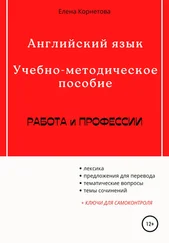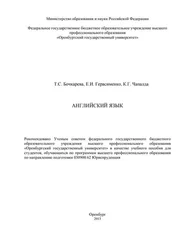Елена Беликова - Английский язык для медиков
Здесь есть возможность читать онлайн «Елена Беликова - Английский язык для медиков» весь текст электронной книги совершенно бесплатно (целиком полную версию без сокращений). В некоторых случаях можно слушать аудио, скачать через торрент в формате fb2 и присутствует краткое содержание. Город: Москва, Год выпуска: 2008, ISBN: 2008, Издательство: Array Конспекты, шпаргалки, учебники «ЭКСМО», Жанр: Языкознание, Медицина, на русском языке. Описание произведения, (предисловие) а так же отзывы посетителей доступны на портале библиотеки ЛибКат.
- Название:Английский язык для медиков
- Автор:
- Издательство:Array Конспекты, шпаргалки, учебники «ЭКСМО»
- Жанр:
- Год:2008
- Город:Москва
- ISBN:978-5-699-24046-3
- Рейтинг книги:4 / 5. Голосов: 1
-
Избранное:Добавить в избранное
- Отзывы:
-
Ваша оценка:
- 80
- 1
- 2
- 3
- 4
- 5
Английский язык для медиков: краткое содержание, описание и аннотация
Предлагаем к чтению аннотацию, описание, краткое содержание или предисловие (зависит от того, что написал сам автор книги «Английский язык для медиков»). Если вы не нашли необходимую информацию о книге — напишите в комментариях, мы постараемся отыскать её.
Английский язык для медиков — читать онлайн бесплатно полную книгу (весь текст) целиком
Ниже представлен текст книги, разбитый по страницам. Система сохранения места последней прочитанной страницы, позволяет с удобством читать онлайн бесплатно книгу «Английский язык для медиков», без необходимости каждый раз заново искать на чём Вы остановились. Поставьте закладку, и сможете в любой момент перейти на страницу, на которой закончили чтение.
Интервал:
Закладка:
Parietal pleura is that portion of the pleura that continues onto the inner aspect of the thoracic wall. It is continuous with the visceral pleura and is lined by the same me—sothelium.
Pleural cavity is a very narrow fluid—filled space that contains monocytes located between the two pleural membranes. It contains no gases and becomes a true cavity only in disease (e. g., in pleural infection, fluid and pus may accumulate in the pleural space). If the chest wall is punctured, air may enter the pleural space (pneumotho—rax), breaking the vacuum, and allowing the lung to recoil. Parietal pleura lines the inner surface of the thoracic cavity; visceral pleura follows the contours of the lung itself.
Pleural cavity: The pleural cavity is the space between the parietal and viscer al layers of the pleura. It is a sealed, blind space. The introduc tion of air into the pleural cavity may cause the lung to col lapse (pneumothorax).
It normally contains a small amount of serous fluid elaborated by mesothelial cells of the pleural membrane.
Pleural reflections are areas where the pleura changes direction from one wall to the other. The sternal line of reflection is where the costal pleura is con tinuous with the mediastinal pleura behind the sternum (from costal cartilages 2–4). The pleural margin then passes inferiorly to the level of the sixth costal cartilage. The costal line of reflection is where the costal pleura becomes continuous with the diaphragmatic pleura from rib 8 in the mid—clavicular line, to rib 10 in the midaxillary line, and to rib 12 lateral to the vertebral column. Pleural recesses are potential spaces not occupied by lung tissue except during deep inspiration. Costodiaphragmatic recesses are spaces below the inferior borders of the lungs where costal and diaphragmatic pleura are in contact. Costomedia—stinal recess is a space where the left costal and mediasti—nal parietal pleura meet, leaving a space due to the cardiac notch of the left lung. This space is occupied by the lingu—la of the left lung during inspiration.
In nervation of the parietal pleura: The costal and peripheral portions of the diaphragmatic pleu ra are supplied by intercostal nerves.
The central portion of the diaphragmatic pleura and the medi astinal pleura are supplied by the phrenic nerve.
New words
visceral – висцеральный
pleura – плевра
dcollagen – коллаген
elastin – эластин
lymphatic channels – лимфатические сосуды
nerves – нервы
squamous – чешуйчатый
microvilli – микроворсинки
parietal pleura – париетальная плевра
visceral pleura – висцеральная плевра
costal – реберный
39. Nasal cavities
The anatomical structures that play a central role in the res piratory system are located in the head and neck as well as the thorax.
Nasal cavities are separated by the nasal septum, which consists of the vomer, the perpendicular plate of the ethmoid bone, and the septal cartilage. The lateral wall of each nasal cavity features three scroll—shaped bony structures called the nasal conchae. The nasal cavities communicate posteriorly with the nasopharynx through the choanae. The spaces inferior to each concha are called meatus. The paranasal sinu—ses and the nasolacrimal duct open to the meati. The inferior concha is a separate bone, and the superior and middle conchae are parts of the ethmoid bone.
Inferior meatus. The only structure that opens to the inferior meatus is the nasolacrimal duct. This duct drains lacrimal fluid (i. e., tears) from theTneaTaraspect of the orbit to the nasal cavity.
Middle meatus: the hiatus semilumaris contains openings of frontal and maxillary sinuses and americy ethmo—idal air cells. The bulla ethmoidalis contains the opening for'the middle ethmoidal air cells.
Superior meatus contains an opening for thff'posterior ethmoidal air cells.
Sphenoethmoidal recess is located above the superior concha and contains an opening for the sphenoid sinus.
Innervation: Somatic innervation. General sensory information from the lateral wall and septum of the nasal cavity is conveyed to the CNS by branches of V, and V2.
Autonomic innervation. Preganglionic parasympathetic fibers destined to supply the glands of the nasal mucosa and the lacrimal gland travel in the nervus intermedius and the greater superficial petrosal branches of the facial nerve (CN VII). These fibers synapse in the pte—rygopalatine ganglion, which is located in the pterygopa—latine fossa. Postganglionic fibers traveling to the mucous glands of the nasal cavity, paranasal air sinuses, hard and soft palate, and the lacrimal gland follow branches of V2 and in some cases V1, to reach their destinations.
New words
anatomical – анатомический
respiratory system – дыхательная система
head – голова
neck – шея
nasal cavities – носовые впадины
the perpendicular plate – перпендикулярная пластина
ethmoid – решетчатый
septal – относящийся к перегородке
nasal conchae – носовой раковина
paranasal – параносовой
sinuses – пазухи
nasolacrimal – назолакримальный
duct – трубочка
drain – проток
tears – слезы
orbit – орбита
maxillary – верхнечелюстной
bulla – булла
40. Pharynx and related areas
The pharynx is a passageway shared by the digestive and respira tory systems. It has lateral, posterior, and medial walls through out, but is open interiorly in its upper regions, communicating with the nasal cavity and the oral cavity. The anterior wall of the laryngopharynx is formed by the larynx. The pharyngeal wall con sists of a mucosa, a fibrous layer, and a muscularis, which is com posed of an inner longitudinal layer and an outer circular layer.
Nasopharynx is the region of the pharynx located directly poste rior to the nasal cavity. It communicates with the nasal cavity through the choanae.
The torus tubarius is the cartilaginous rim of the auditory The pharyngeal recess is the space located directly above and behind the torus tubarius; it contains the nasopharyn—geal tonsil. The salpingopharyngeal fold is a ridge consisting of mucosa and the underlying salpingopharyngeus muscle.
Oropharynx is the region of the pharynx located directly posterior to the oral cavity. It communicates with the oral cavity through a space called the fauces. The fauces are bounded by two folds, consisting of mucosa and muscle, known as the anterior and posterior pillars.
The tonsillar bed is the space between the pillars that houses the palatine tonsil.
Laryngopharynx is the region of the pharynx that surrounds the larynx. It extends from the tip of the epiglottis to the cricoid car tilage. Its lateral extensions are known as the piriform recess.
Oral cavity: the portion of the oral cavity that is posterior to the lips and anterior to the teeth is called the vestibule. The oral cavi ty proper has a floor formed by the mylohyo—id and geniohyoid muscles, which support the tongue. It has lateral walls, consisting of the buccinator muscles and buccal mucosa, and a roof formed by the hard palate an teriorly and the soft palate posteriorly. Its posterior wall is absent and is replaced by an opening to the oropharynx, which is flanked by the pillars of the fauces.
The palate separates the nasal and oral cavities.
Hard palate is formed by the palatine process of the maxilla and the horizontal palate of the palatine bone. Its mu—cosa is supplied with sensory fibers from CN V2.
Читать дальшеИнтервал:
Закладка:
Похожие книги на «Английский язык для медиков»
Представляем Вашему вниманию похожие книги на «Английский язык для медиков» списком для выбора. Мы отобрали схожую по названию и смыслу литературу в надежде предоставить читателям больше вариантов отыскать новые, интересные, ещё непрочитанные произведения.
Обсуждение, отзывы о книге «Английский язык для медиков» и просто собственные мнения читателей. Оставьте ваши комментарии, напишите, что Вы думаете о произведении, его смысле или главных героях. Укажите что конкретно понравилось, а что нет, и почему Вы так считаете.












